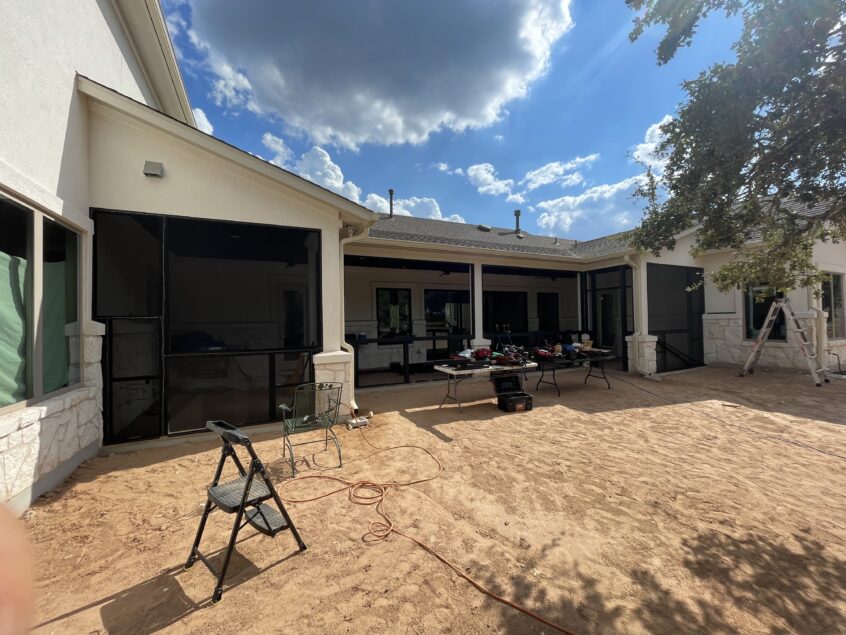Screen in a Porch – How It Works
Screening in a porch might sound straightforward, but doing it right takes careful planning, precise construction, and a bit of craftsmanship. Here’s a look at how we tackle each project from start to finish—ensuring you end up with a space that’s both beautiful and built to last.
Step 1: Collaborative Planning & Design
Every successful project starts with a clear vision. That’s why we begin by sitting down with our customers to talk through ideas, goals, and any special requirements. Whether you’re envisioning a cozy outdoor lounge or a fully loaded “Catio,” we work with you to plan every detail. By the end of this stage, we have a solid design that aligns perfectly with your needs and style preferences.
Step 2: Establishing the Screen Planes
Once on-site, our first task is to create what we call “screen planes.” This simply means making sure the wood frame is perfectly plumb (vertically straight) and aligned. We measure, level, and brace the frame so there are no unwanted angles or subtle twists. This might sound basic, but it’s crucial for a clean finish and a porch that won’t warp or sag over time.
Step 3: Defining the Screened Porch Perimeter
Next, we establish the porch’s perimeter by attaching the framing to the existing structure—usually the house—and to the floor, whether it’s a concrete slab or a wood deck. We rely on high-quality, corrosion-resistant steel anchors and screws to ensure the frame holds up under everyday wear and tear, as well as being weather-proof.
At this stage, we also pay special attention to framing for the doors. Doors see a lot of use, so proper support here prevents issues down the road.
Step 4: Adding Vertical Screen Porch Supports
With the perimeter set, we divide the walls into sections using vertical supports. The spacing depends on the project:
Frequent Vertical Supports
- For a Catio or a porch that needs shelving and perches, we’ll add more verticals. This extra framing makes it easy to attach features without compromising stability.
Minimalist Design
- If preserving the view is a priority, we’ll opt for fewer vertical supports. The goal here is to maintain an open, airy feel while still providing enough structure for the screens.
After the verticals are in place, we apply caulk to seal any small gaps around the outer edges. This step is key for keeping insects out and making the entire porch as bug-proof as possible.
Step 5: Screening & Trimming
Once the framework is ready, it’s time to attach the screen. We use a tough, durable screen material that can handle everyday impacts and weather. Our method involves thousands of staples—yes, literally thousands—to maximize the screen’s longevity and minimize the need for future maintenance.
Stretching the Screen
We attach the screen with tension, ensuring there are no waves or loose spots. This takes a bit of skill and patience, but the result is a smooth, professional finish.
Applying Trim
Next, we install trim pieces to cover the staples and give the porch a polished look. Typically, we stain the trim to match the structural wood, but we can also paint it to meet HOA requirements or personal preference.
Step 6: Installing the Door
A solid door is just as important as the rest of the structure. We handcraft our screen doors using the same high-quality wood and screen, making them sturdy enough to handle daily use without warping. Instead of the flimsy handles often found on standard screen doors, we use normal doorknobs and locks for a more secure, long-lasting solution.
Step 7: Final Touches
Before calling it a day, we do a thorough inspection and apply any necessary stain or paint touch-ups. This finishing step protects the wood from the elements and ensures everything looks cohesive. In the end, you’re left with a beautiful, durable, and functional screened porch—ready for morning coffees, evening gatherings, or just a peaceful place to relax.
Frequently Asked Questions
What type of screen material is best for a screened-in porch?
We use a specialized screen material called SuperScreen, which is highly durable and resistant to tears, UV rays, and everyday wear and tear. This ensures your porch remains functional and low-maintenance for years to come.
How do you ensure the screen stays tight and doesn’t sag over time?
We use thousands of staples to securely fasten the screen and apply proper tension to prevent sagging. Additionally, we cover all staples with trim for a clean, finished look while adding extra reinforcement to keep the screen taut.

